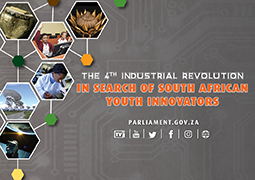
Young people hailed Covid-19 as the catalyst that propelled South Africa to embrace technological advances that saw many people having to work from home, while schools operated through remote learning. They were speaking in Parliament in nationwide Youth Innovation Exhibition sessions launched yesterday by Parliament as part of creating a dialogue with young people on the Fourth Industrial Revolution (4IR).
Parliament, through the Office of the Deputy Speaker, Mr Lechesa Tsenoli, plans to hold more information sessions on: “Celebrating Youth Innovation in the 4IR and Beyond”. The sessions will consist of information sharing and awareness sessions in the country’s nine provinces.
The 4Ir launch was attended by student innovators from Sinenjongo High School in Milnerton, who represented South Africa during the World Robotic Olympiad held in Germany. Other students attended the launch from Spine Road High School in Mitchells Plain and Wesbank High School in Malmesbury. Other stakeholders included the Centre for Scientific and Industrial Research (CSIR) and the Technology Innovation Agency (TIA).
Delivering his opening remarks, Mr Tsenoli said the programme is designed to find out what young people are doing to harness the power of technology, while finding innovative solutions to some of South Africa’s problems. “There are problems that need solving and we need to link young people with leading technology industries in the country to help shape their visions.” Mr Tsenoli also spoke about how during the Covid-19 pandemic Members of Parliament had to adapt and embrace new technologies.
The Chairperson of the Portfolio Committee on Higher Education, Science and Innovation, Ms Nompendulo Mkhatshwa, said it is important to harness innovations to achieve more inclusive and better societies. “We must view technology as a helping aid,” she added.
The CSIR told young people about the many homegrown solutions it has formulated and explained how it offers support to young innovators. The CSIR also urged young innovators to look at the potential to commercialise technological innovation.
The TIA is a public entity that aims to bridge the gap between research and development conducted in tertiary institutions, science councils and public entities and the private sector. Through the TIA, innovators like Swelihle Magubane from KwaZulu-Natal have seen their innovations become a reality. Swelihle devised an innovative way to assist his neighbour, who is wheelchair bound, to deal with rainy weather conditions by operating a wheelchair umbrella-like cover.
Another young innovator supported by TIA, Senzo Masumpa, said Khayelitsha is known for crime, unemployment and substance abuse. However, they have now come up with an online platform that incentivises young people to do well in their communities by volunteering or job shadowing. They then earn a digital reward called Z’lato points that they can use to buy airtime or data.
Mr Buti Manamela, Deputy Minister of the Department of Higher Education, Science and Innovation, said young innovators should also consider studying at TVET colleges where they will receive practical skills.
In closing the launch session, Mr Tsenoli said: “We need to capture these young people at the forefront of innovative solutions and see what support we can provide to them.” He further welcomed the fact that the innovations discussed yesterday display a human element that showcased how the innovations solve human problems.
Jabulani Majozi
21 June 2023

